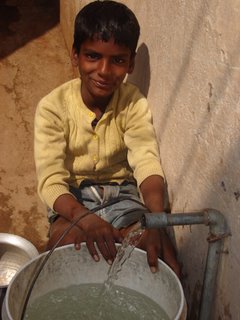 Now that we have a doctor around, we are beginning to think about all the necessary inputs for students to be able to learn. This is the phase of development where we start to approach different partner organizations to deliver services to the students and even the entire neighborhood. The school is a natural magnet for this. Health predicates any ability to learn, so it seems natural to start with the largest input to the community health: water.
Now that we have a doctor around, we are beginning to think about all the necessary inputs for students to be able to learn. This is the phase of development where we start to approach different partner organizations to deliver services to the students and even the entire neighborhood. The school is a natural magnet for this. Health predicates any ability to learn, so it seems natural to start with the largest input to the community health: water.Work in Progress: Water
A non-profit in Hyderabad which partners with an American scientific firm is interested in making the Mastan Nagar neighborhood an urban water pilot project. (Previous water projects were in rural villages.) This would be a huge improvement for the neighborhood. The water supply in the neighborhood is erratic, there is never enough, and it is definitely not purified.
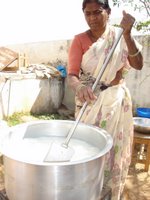
The school has water delivered by government tanker truck. We always run out of water before the next delivery is due. Then the whole school grinds to a halt. We need water for the "splash" toilets (no flush), water to cook the school lunch (right), and the very real need for drinking water (it is HOT here). However, a bore well would not solve the problem.
The groundwater in the area is contaminated in part due to several water buffalo herds and the common practice among the neighborhood residents to go "au naturale" when nature calls. Here (below) are our very own neighborhood buffaloes taking a bath. They live right behind the temple. Finally, there are some latrines among the more established hut areas. While these help protect the surrounding land a bit, but they do not feed into any formal sewage system.
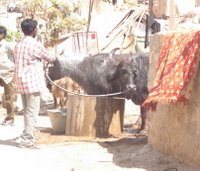
Then there is the problem of storing the water. The tankers come to the neighborhood on an irregular schedule to fill up the old, leaking concrete water tanks and short, squatty water "towers" around the neighborhood. On occasion, from around 10:30 to 11:30 AM, the water actually comes out of the water pipes (first picture). Sometimes the water just doesn't come on, so when it does, every available mother and the larger children (seven and older) drop everything and pile buckets, cooking pots, anything to capture the water. That means I have a flight of the older students racing out of the school everytime the water comes on. The alternative is fighting for a place in line at the "towers" when the tanker comes, or sneaking water from the private tanks. (Sometimes, the more upscale groups of huts get together to purchase private, black plastic water containers.) I understand why they have to go.
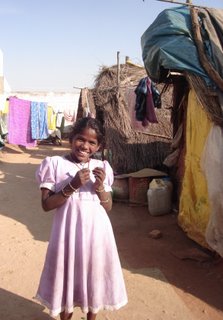 Sirnu, the boy in the very first picture, just spent two weeks away from school due to the water supply problem. He is alone with his lovely, tiny, frail grandmother while his parents are working on the new ring road around Hyderabad. She is a very particular lady who keeps things very clear. She didn't want him to go until the morning washing was well provided for (several of buckets of water). Then she would send him to school. Instead of going, he just stayed away, thinking he would be in trouble for going late. We tracked him down (quite a few times) to try to convince him to come back anytime, or just come late. I'll see him again tomorrow for another attempt. On the right is Yallamma. She is in the same situation. Her household lost all their men to various tragedies. She is alone with her mother and her aunt who is heavily pregnant. A few weeks ago, they decided they needed her to fetch the water since the baby is coming any minute. Gopal and I talked her into going to the school for lunch and the afternoon classes for the next few months. She is a firecracker, the school is just not as fun without her.
Sirnu, the boy in the very first picture, just spent two weeks away from school due to the water supply problem. He is alone with his lovely, tiny, frail grandmother while his parents are working on the new ring road around Hyderabad. She is a very particular lady who keeps things very clear. She didn't want him to go until the morning washing was well provided for (several of buckets of water). Then she would send him to school. Instead of going, he just stayed away, thinking he would be in trouble for going late. We tracked him down (quite a few times) to try to convince him to come back anytime, or just come late. I'll see him again tomorrow for another attempt. On the right is Yallamma. She is in the same situation. Her household lost all their men to various tragedies. She is alone with her mother and her aunt who is heavily pregnant. A few weeks ago, they decided they needed her to fetch the water since the baby is coming any minute. Gopal and I talked her into going to the school for lunch and the afternoon classes for the next few months. She is a firecracker, the school is just not as fun without her.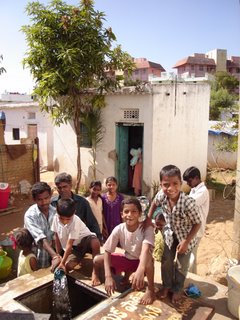 Here is what happens on a typical water delivery day: At the school, we have an ancient, leaky, partially below ground concrete water tank (left). The tanker truck backs into the schoolyard in a cloud of diesel fumes, then they attach a wide, plastic hose to the giant-sized spigot. They drag the giant hose into the yard in front of the little office (in the background), then across the cooking area to the tank. Futzing around to get the truck in the right position, then linking the pieces of the hoses, then actually getting the hose to the tank requires about ten mintues. They turn on the water and after another fifteen minutes, the tank is full. Then they have to disassemble the whole hose, crank the truck back on, and do eight or nine attempts to pull the truck out of the schoolyard. About fifteen mintues later, the mud starts. The whole yard in front of the office and all the way out to the road outside the school gate starts to turn muddy. Once the ground is saturated, fast-running seepage causes wide, shallow water flows to all the way from the school to the temple, about one quarter of a mile away. We always run out of water before the next delivery is due...we always have to call the tanker back early.
Here is what happens on a typical water delivery day: At the school, we have an ancient, leaky, partially below ground concrete water tank (left). The tanker truck backs into the schoolyard in a cloud of diesel fumes, then they attach a wide, plastic hose to the giant-sized spigot. They drag the giant hose into the yard in front of the little office (in the background), then across the cooking area to the tank. Futzing around to get the truck in the right position, then linking the pieces of the hoses, then actually getting the hose to the tank requires about ten mintues. They turn on the water and after another fifteen minutes, the tank is full. Then they have to disassemble the whole hose, crank the truck back on, and do eight or nine attempts to pull the truck out of the schoolyard. About fifteen mintues later, the mud starts. The whole yard in front of the office and all the way out to the road outside the school gate starts to turn muddy. Once the ground is saturated, fast-running seepage causes wide, shallow water flows to all the way from the school to the temple, about one quarter of a mile away. We always run out of water before the next delivery is due...we always have to call the tanker back early.Over the past few months, we've gotten to know the young tanker driver and his two helpers. They seem to like the visits. I would like to see them a bit less. But even if we got the tank leak fixed, we still get frogs, waterstriders, and even mosquitos inside the tank because the hatch is left open when it is in heavy use. I am talking to the residents and asking them to close it up more often, but with a public tank, that is a difficult goal.
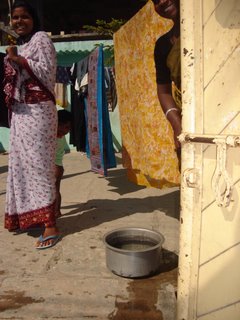
Here are pictures of the typical water storage container for a family. The ladies are usually in charge of retrieving the water. Then the children are in charge of knocking the covers off the containers
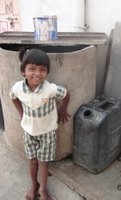 and playing with the water. The little one on the right just scuttled behind her mommy (in the white and red sari) after I caught her throwing stones into the pot. These open containers immediately draw a layer of flimy dust. Then the insects start taking notice. As the weather grows hotter, this is not a good situation.
and playing with the water. The little one on the right just scuttled behind her mommy (in the white and red sari) after I caught her throwing stones into the pot. These open containers immediately draw a layer of flimy dust. Then the insects start taking notice. As the weather grows hotter, this is not a good situation.Here is a solutio
 n (left). A covered, 11 liter jug of pure water is delivered daily directly from a modern water treatment plant to the door of a hut. Other ideas: small group tanks and better underground and above ground ("tower") tanks. This will be a great joy to work on...will keep the news on this very current. I know there are far, far more experienced people working on water issues and I can't wait to learn from them.
n (left). A covered, 11 liter jug of pure water is delivered daily directly from a modern water treatment plant to the door of a hut. Other ideas: small group tanks and better underground and above ground ("tower") tanks. This will be a great joy to work on...will keep the news on this very current. I know there are far, far more experienced people working on water issues and I can't wait to learn from them.
Hello Leigh Ann,
ReplyDeleteI am Kalpana and I work with Roy. I really admire the work you are doing here. As I was reading this post, I realized I see this scene every single day (there is a slum in my neighborhood) and I have got so immune to it that nothing looks wrong. Good luck in your work and keep updating this blog regularly. I am learning :)
-Kalpana